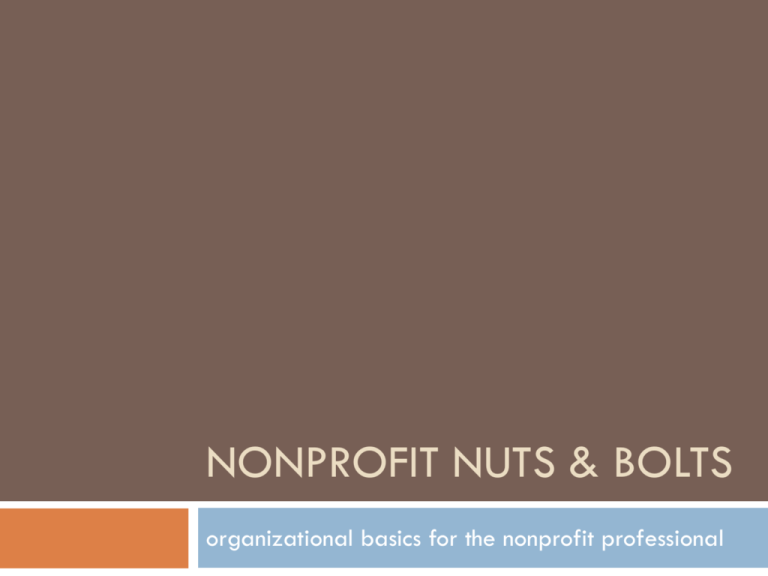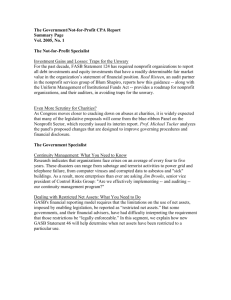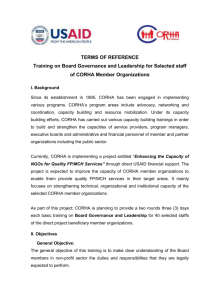Nonprofit Nuts & Bolts
advertisement

NONPROFIT NUTS & BOLTS organizational basics for the nonprofit professional Agenda The Nonprofit Sector Governance Board vs Staff Organization structure Nonprofit Lifecycle Strategic Planning & Evaluation Nonprofit Finances Volunteers Risk Management Q&A Three Sectors of the Economy Government For-Profit Nonprofit Three Sectors of the Economy Government Federal State County City For-Profit CITIZENS Sole proprietorships LLCs Partnerships Cooperatives Corporations S-Corporations OWNER/SHAREHOLDERS Nonprofit 501 c 3’s: (arts, education, health & human services, environmental, churches, foundations, etc…) Social welfare orgs Membership orgs STAKEHOLDERS The Ownership Question A nonprofit corporation is formed to carry out a public purpose, whether that be religious, educational, charitable, scientific or some other. It is prohibited from acting in a manner that results in private inurement to individuals. How can that be? Someone has to own it, right? No, not really. The nonprofit organization is not “owned” by the person or persons that started it. It is a public organization that belongs to the public at-large. The parties responsible to operate the organization for the stakeholders are the members of the board of directors. Nonprofit/Tax-Exempt Organizations *Graph from the Nat’l Center for Charitable Statistics website: nccsweb.urban.org How big are we? 1,429,801 tax-exempt organizations, including: 966,599 public charities 96,584 private foundations 366,618 other types of nonprofit organizations, including chambers of commerce, fraternal organizations and civic leagues. (Source: NCCS Business Master File 6/2014) In 2010, nonprofits accounted for 9.2% of all wages and salaries paid in the United States. (Source: The Nonprofit Almanac, 2012) Nonprofit Share of GDP was 5.5% in 2012. (Source: The Nonprofit Almanac, 2012) How big are we? In 2012, public charities reported over $1.65 trillion in total revenues and $1.57 trillion in total expenses. Of the revenue: 21% came from contributions, gifts and government grants. 73% came from program service revenues, which include government fees and contracts. 6% came from "other" sources including dues, rental income, special event income, and gains or losses from goods sold. (Source: NCCS Core Files 2012 80/20 ratio. How does hunger relief orgs compare? Oregon Food Bank Growth Spurt! Operating Public Charities – 501 c 3’s with $25K or more in revenue 2003: 260,537 2013: 576,757 - 19.0% (of all nonprofits) - 40.6% Percentage Change: 121.4% Governance: So many rules!! Policies are many, Principles are few, Policies will change, Principles never do. -John C. Maxwell Governance State and Federal Government Governance WA Secretary of State Articles IRS Initial Bylaws Governance Articles / Bylaws State and Federal Government Articles of Incorporation Filed at inception with Washington’s Secretary of State – establishes a Nonprofit Corporation Specifies: Name Address Purpose / Mission Statement Initial board members Membership Personal liability Dissolution Bylaws Filed at inception and submitted to IRS to obtain 501c3 status Specifies: Size of the board and how it will function Roles and duties of directors and officers Rules and procedures for holding meetings, electing directors, and appointing officers Board committees Conflict of interest policies and procedures State nonprofit laws usually address nonprofit governance matters. However, you can choose different rules, as long as they don’t violate state law and are included in your bylaws. Governance Do Articles and Bylaws matter to me? YES! Read them every now and again Check Do for compliance: you need to consider updating your bylaws? Is your board committee working within or outside its bounds? Are you engaging your membership accordingly? Pop Quiz! What document specifies what constitutes a quorum? Where would you find information on what authority is vested in the members of your organization? What group do your board members represent? Articles / Bylaws State and Federal Government Board Staff Governance & Management Board / Staff “and” “versus” The Hand-off Board and Staff BOARD Governance & Fundraising Adherence to articles, bylaws; creation of policies Financial Oversight Advocacy Stakeholder representation Oversight of Ex. Dir. Strategic Planning STAFF Operations & Fundraising Management Budgeting / Accounting Personnel Programs Evaluation Strategic Planning Governance & Management Employee Handbook Staff Operations Manual Strategic Plan Articles / Bylaws State and Federal Government Board Policies & Procedures Legal Responsibilities of Board The Tree D’s Duty of care: Actively participate in organizational planning and decisionmaking and to make sound and informed judgments. Duty of loyalty: When acting on behalf of the organization, board members must put the interests of the nonprofit before any personal or professional concerns and avoid potential conflicts of interest. Duty of obedience: Board members must ensure that the organization complies with all applicable federal, state, and local laws and regulations, and that it remains committed to its established mission. Fiduciary Responsibility Board members must evaluate financial policies, approve annual budgets, and review periodic financial reports to ensure that the organization has the necessary resources to carry out its mission and remains accountable to its donors and the general public. Organizational Structure Board of Directors Nominating Com. Exec Com. Executive Director Finance Com. Mktg Com. Prgms Com. Dev Com. Operations Marketing Programs Development Working with Committees Extent of Committee’s authority should be specified in bylaws Ex. Dir. may or may not be on committee with staff members Take advantage of committee members’ expertise When you find you have more experience, take advantage of their advocacy and stakeholder representation roles Committee are often vehicles for recruiting new board members. Committee members should feel valued. Mission Creep Causes: Chasing the money! Excitable board Excitable staff Dangers: Staff burnout Donor/constituent confusion Loss of organizational integrity Using Governance to Define Operations!! Nonprofit Lifecycle Nonprofit Lifecycle Judith Sharken Simon, 2002 – “The 5 Life Stages of Nonproifts” Nonprofit Lifecycle Strategic Planning & Evaluation Nonprofit Lifecycle Judith Sharken Simon, 2002 – “The 5 Life Stages of Nonproifts” Strategic Planning & Evaluation Update your strategic plan every 3 – 5 years: Revisit Mission/Vision Define internal/external opportunities and threats Include well defined goals with timelines and project owners Include evaluation methods and benchmarks for programs USE the plan! They can be wonderful management tools that keep your organization from stagnating. Strategic Planning & Evaluation Strategic Planning Resources: http://www.councilofnonprofits.org/strategic-businessplanning-for-nonprofits Evaluation Resources: http://www.councilofnonprofits.org/resources/resourcestopic/evaluation-and-measurement https://nonprofitquarterly.org/management/22549-usingoutcomes-to-measure-nonprofit-success.html Nonprofit Finances Nonprofit Finances Stanford Social Innovation Review: “Running a nonprofit is generally more complicated than running a comparable size for-profit business.” “When a for-profit business finds a way to create value for a customer, it has generally found its source of revenue; the customer pays for the value. With rare exceptions, that is not true in the nonprofit sector. When a nonprofit finds a way to create value for a beneficiary (for example, integrating a prisoner back into society or saving an endangered species), it has not identified its economic engine. That is a separate step.” Our beneficiaries are our cost-drivers! Nonprofit Finances Same basic financial statements as for-profits: Balance Sheet (Statement of Financial Position) Income Statement (Statement of Activities) Cash Flow Oddities Unrestricted, temporarily restricted and permanently restricted assets In-kind contributions, pledges Special Events and Membership Dues (know what portion is tax-deductible!) Nonprofit Finances How do funders use financial statements to evaluate health of a nonprofit: Cash reserves, operating deficits, debt Ratio of earned vs. contributed income “Overhead Ratio” – Under major scrutiny right now! Nonprofit Finances Endowments Permanently restricted capital Interest income is only spendable cash Is it what you need most? Managing Grant Money This is a restricted asset Must track spending of grant money very carefully! Nonprofits have been sued for misuse of grant funding Nonprofit Finances What if a nonprofit makes a profit? Questions on Finances? Volunteers Volunteers According to the IRS, 85% of all charitable nonprofits have no paid staff and are run entirely by volunteers. Volunteers are not entitled to compensation (and receiving it can turn them into employees in the eyes of the law). In most states volunteers are not covered by workers' compensation insurance which is why some nonprofits elect to purchase "volunteer accident insurance.“ Train, supervise, and evaluate volunteers! Provide a volunteer handbook. Volunteers Know what’s deductible and not deductible for volunteers: Item or expense must be absolutely critical to performing volunteer duty Value of their time not deductible KEEP RECORDS – miles, receipts, hours, etc. If more than $250 value, charity must provide written acknowledgement. Charity must keep records for “reimbursements” so that they are not regarded as compensation. You must keep track of hours if: The volunteer time results in the creation or enhancement of non-financial assets, such as volunteer labor to renovate a child care center; or The services volunteered are specialized skills, such as those provided by accountants, nurses, electricians, teachers, or other professionals and craftsmen. http://www.councilofnonprofits.org/resources/resources-topic/volunteers Risk Management Risk Management Reducing the likelihood or severity of some unknown occurrence that could prevent or seriously derail a nonprofit from fulfilling its mission. Hiring – checking references Financial – establishing cash reserves, separation of duties (watch out for the “trusted employee!”) Data – backing up Accidents – ensuring a safe work environment Governance – ensure board members are fully trained Risk Management Written Policy Statements that aid in Risk Management: Confidentiality Agreement Conflict of Interest Document Retention and Destruction Executive Compensation Gift Acceptance Joint Venture and Partnership Media Spokesperson Whistleblower Protection http://www.councilofnonprofits.org/resources/resourcestopic/risk-management-and-insurance#sthash.QBgvm9JR.dpuf







